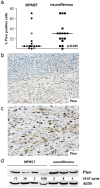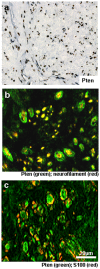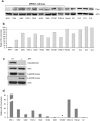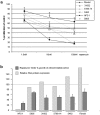Impaired Pten expression in human malignant peripheral nerve sheath tumours
- PMID: 23139750
- PMCID: PMC3490977
- DOI: 10.1371/journal.pone.0047595
Impaired Pten expression in human malignant peripheral nerve sheath tumours
Abstract
Malignant peripheral nerve sheath tumours (MPNST) are aggressive sarcomas that develop in about 10% of patients with the genetic disease neurofibromatosis type 1 (NF1). Molecular alterations contributing to MPNST formation have only partially been resolved. Here we examined the role of Pten, a key regulator of the Pi3k/Akt/mTOR pathway, in human MPNST and benign neurofibromas. Immunohistochemistry showed that Pten expression was significantly lower in MPNST (n=16) than in neurofibromas (n=16) and normal nervous tissue. To elucidate potential mechanisms for Pten down-regulation or Akt/mTOR activation in MPNST we performed further experiments. Mutation analysis revealed absence of somatic mutations in PTEN (n=31) and PIK3CA (n=38). However, we found frequent PTEN promotor methylation in primary MPNST (11/26) and MPNST cell lines (7/8) but not in benign nerve sheath tumours. PTEN methylation was significantly associated with early metastasis. Moreover, we detected an inverse correlation of Pten-regulating miR-21 and Pten protein levels in MPNST cell lines. The examination of NF1-/- and NF1+/+Schwann cells and fibroblasts showed that Pten expression is not regulated by NF1. To determine the significance of Pten status for treatment with the mTOR inhibitor rapamycin we treated 5 MPNST cell lines with rapamycin. All cell lines were sensitive to rapamycin without a significant correlation to Pten levels. When rapamycin was combined with simvastatin a synergistic anti-proliferative effect was achieved. Taken together we show frequent loss/reduction of Pten expression in MPNST and provide evidence for the involvement of multiple Pten regulating mechanisms.
Conflict of interest statement
Figures




Similar articles
-
Dual mTORC1/2 inhibition induces anti-proliferative effect in NF1-associated plexiform neurofibroma and malignant peripheral nerve sheath tumor cells.Oncotarget. 2016 Jun 14;7(24):35753-35767. doi: 10.18632/oncotarget.7099. Oncotarget. 2016. PMID: 26840085 Free PMC article.
-
PTEN and NF1 inactivation in Schwann cells produces a severe phenotype in the peripheral nervous system that promotes the development and malignant progression of peripheral nerve sheath tumors.Cancer Res. 2012 Jul 1;72(13):3405-13. doi: 10.1158/0008-5472.CAN-11-4092. Epub 2012 Jun 14. Cancer Res. 2012. PMID: 22700876 Free PMC article.
-
Transgenic mice overexpressing neuregulin-1 model neurofibroma-malignant peripheral nerve sheath tumor progression and implicate specific chromosomal copy number variations in tumorigenesis.Am J Pathol. 2013 Mar;182(3):646-67. doi: 10.1016/j.ajpath.2012.11.017. Epub 2013 Jan 13. Am J Pathol. 2013. PMID: 23321323 Free PMC article.
-
Tumor suppressor mutations and growth factor signaling in the pathogenesis of NF1-associated peripheral nerve sheath tumors: II. The role of dysregulated growth factor signaling.J Neuropathol Exp Neurol. 2005 Jan;64(1):1-9. doi: 10.1093/jnen/64.1.1. J Neuropathol Exp Neurol. 2005. PMID: 15715079 Review.
-
Malignant Peripheral Nerve Sheath Tumor.Surg Oncol Clin N Am. 2016 Oct;25(4):789-802. doi: 10.1016/j.soc.2016.05.009. Surg Oncol Clin N Am. 2016. PMID: 27591499 Review.
Cited by
-
Decorin as a prognostic biomarker in patients with malignant peripheral nerve sheath tumors.Oncol Lett. 2019 Mar;17(3):3517-3522. doi: 10.3892/ol.2019.9959. Epub 2019 Jan 23. Oncol Lett. 2019. PMID: 30867792 Free PMC article.
-
Recent Advances in the Diagnosis and Pathogenesis of Neurofibromatosis Type 1 (NF1)-associated Peripheral Nervous System Neoplasms.Adv Anat Pathol. 2018 Sep;25(5):353-368. doi: 10.1097/PAP.0000000000000197. Adv Anat Pathol. 2018. PMID: 29762158 Free PMC article. Review.
-
The Challenge of Cancer Genomics in Rare Nervous System Neoplasms: Malignant Peripheral Nerve Sheath Tumors as a Paradigm for Cross-Species Comparative Oncogenomics.Am J Pathol. 2016 Mar;186(3):464-77. doi: 10.1016/j.ajpath.2015.10.023. Epub 2015 Dec 28. Am J Pathol. 2016. PMID: 26740486 Free PMC article. Review.
-
Neurofibromatosis type I with malignant peripheral nerve sheath tumors in the upper arm: A case report.Medicine (Baltimore). 2019 Mar;98(13):e15017. doi: 10.1097/MD.0000000000015017. Medicine (Baltimore). 2019. PMID: 30921223 Free PMC article.
-
Malignant peripheral nerve sheath tumor: models, biology, and translation.Oncogene. 2022 Apr;41(17):2405-2421. doi: 10.1038/s41388-022-02290-1. Epub 2022 Apr 7. Oncogene. 2022. PMID: 35393544 Free PMC article. Review.
References
-
- Huson SM (1994) Neurofibromatosis 1: a clinical and genetic overview. In: Huson SM, Hughes RAC, editors. The Neurofibromatoses. London: Chapman and Hall Medical. 160–203.
-
- Legius E, Dierick H, Wu R, Hall BK, Marynen P, et al. (1994) TP53 mutations are frequent in malignant NF1 tumors. Genes Chromosomes Cancer 10: 250–255. - PubMed
-
- Perry A, Kunz SN, Fuller CE, Banerjee R, Marley EF, et al. (2002) Differential NF1, p16, and EGFR patterns by interphase cytogenetics (FISH) in malignant peripheral nerve sheath tumor (MPNST) and morphologically similar spindle cell neoplasms. J Neuropathol Exp Neurol 61: 702–709. - PubMed
Publication types
MeSH terms
Substances
LinkOut - more resources
Full Text Sources
Research Materials
Miscellaneous

